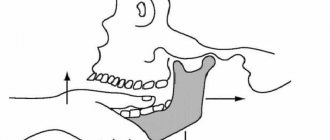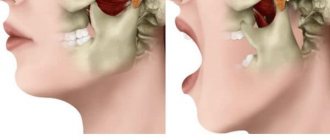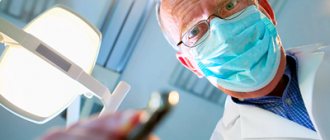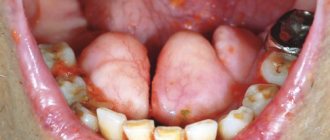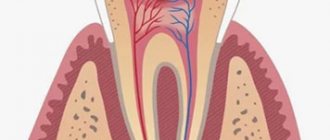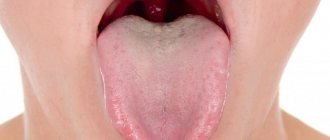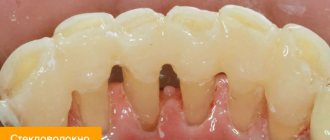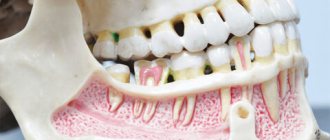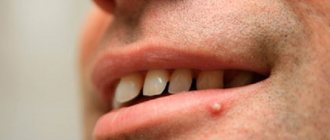No one is immune from jaw displacement. Dislocation of the lower jaw can occur either as a result of a blow or when the mouth is suddenly opened. But there are a number of factors that provoke the occurrence of such situations. How to behave if jaw displacement occurs? How soon can it be put back in place, and where should one go if the lower jaw is dislocated? Experts answer these questions.
Dislocation of the lower jaw is a situation when the articular head of the temporomandibular joint is displaced. Dislocation can only affect the lower jaw, since the upper jaw is immobile. The mandible is connected to the temporal bone by the TMJ, which helps the mandible move.
Why does dislocation of the lower jaw occur?
Mandibular displacement can occur because:
- the patient suddenly opened his mouth during a conversation or yawned;
- the man dropped his jaw sharply;
- the patient suffers from certain diseases that have weakened the skeletal system and articular ligaments. Among the most common diseases that provoke dislocation of the lower jaw are osteomyelitis, rheumatism, arthritis, etc.;
- a person has a habit of opening bottles with his teeth;
- the temporomandibular joint was affected due to improper distribution of the load on the teeth (for example, if on one side there are no chewing teeth, but on the other side they are there and do more work).
Symptoms
Signs of a dislocation are clearly visible, first of all, pain and discomfort in the area of the damaged joint, deterioration of movement, increased work of the salivary glands, swelling in the affected area.
Bilateral anterior dislocation is characterized by the following symptoms:
- Inability to close teeth, mouth half open.
- Swelling of the lower border of the temporal zone, pain.
- deterioration .
With a unilateral anterior dislocation, symptoms appear on only one side.
Find out what to do if a tooth is broken at the root
Bilateral posterior dislocation is determined by the following symptoms:
- Painful sensations in the lower border of the temporal zone, swelling.
- Shift of the jaw towards the throat.
- Inability to open teeth.
- Feeling of suffocation when lying down.
- Significant deterioration in speech function, slurred pronunciation.
The following manifestations are typical for lateral dislocation:
- shifts in the opposite direction of the dislocation; it is impossible to put it in place on your own.
- Pain and swelling in the area of the affected joint.
- Unintelligible pronunciation of words.
The symptoms of subluxation are not very different, but less pronounced. The jaw partially retains mobility; a click is heard when changing position. The mouth is slightly open only with anterior damage. There is increased activity of the salivary glands.
How to understand that a dislocation of the lower jaw has occurred?
The symptoms of dislocation of the lower jaw are quite clear:
- it becomes impossible to open your mouth;
- pain is felt in the projection of the jaw, as well as in the area of the temporal bone;
- after dislocation of the lower jaw there may be speech impairments;
- redness may be observed in the area of the temporomandibular joint;
- the lower jaw is pushed forward or shifted to the side;
- against the background of joint dislocation, uncontrolled salivation occurs.
As a rule, a person immediately understands that something is wrong with the lower jaw. Visually, the displacement of the lower jaw is also visible. If you notice similar symptoms of dislocation, you should urgently seek help from a doctor.
Classification
All jaw dislocations can be classified according to various indicators:
| According to the placement of the articular head relative to the fossa (it is indicated in which direction it came out) |
|
| By location: |
|
| By statute of limitations: |
|
| By severity: |
|
| By etiology: |
|
Any dislocation can and should be treated. Immediately after the incident, you should go to a hospital or emergency room to seek qualified medical care.
What types of dislocations of the lower jaw are there?
Depending on the side of displacement of the articular head, there are:
- posterior dislocation of the lower jaw (when the jaw moves back);
- anterior dislocation of the lower jaw (when the jaw is pushed forward).
Based on the nature of the injury, we can distinguish:
- complex dislocation of the jaw, when soft and hard tissues are affected, and an open wound is visible;
- simple or closed dislocation of the lower jaw, when the displacement of the jaw bones is not visualized.
Based on the number of affected joints (and there are two of them) in articular dislocation of the lower jaw, the following are distinguished:
- bilateral dislocation of the lower jaw is a complex diagnosis in which the jaw “pops out” of both joints and is therefore pushed forward, the mouth remains slightly open, the jaw moves forward, the person is drooling, and there are problems with speech;
- unilateral articular dislocation of the lower jaw, when one temporomandibular joint is involved, while the chin shifts towards the unaffected joint.
If, when the lower jaw is dislocated, the tips of the bones do not touch each other, a complete dislocation of the lower jaw is diagnosed. If the ends of the bones partially touch, most likely the patient has articular subluxation of the lower jaw.
First aid
If you have dislocated your jaw, you should not make sudden movements, as they can lead to a deterioration in your health. In case of severe pain, it is recommended to take any analgesic, but only if you are sure that you are not allergic to its components. With this pathology, there is already an increase in blood pressure and difficulty breathing, and an allergic reaction to an unfamiliar drug will only worsen the condition.
Then you need:
- Fix the knocked-out jaw in one position with a bandage made from available materials (as with any other sprain) to prevent it from moving even further.
- Make something like a gag out of absorbent fabric to remove excess saliva.
- Call an ambulance. If you are unable to speak on your own, you should ask neighbors, passers-by, or employees of nearby stores to call an ambulance if the injury occurred on the street. If there is a hospital nearby, it is better to go straight to the emergency room of a medical institution.
It is not recommended to speak if the jaw apparatus is injured , since any movements of the mouth will be painful. Trying to straighten your jaw at home without proper practice is also not worth it.
Self-treatment of a jaw dislocation, even if it occurs during normal yawning, can lead to long-term joint dysfunction and damage to the setter's fingers.
How can you determine that a dislocation of the lower jaw has occurred?
As we said above, based on the symptoms, the patient immediately understands that something is wrong with his lower jaw. A doctor will be able to make an accurate diagnosis based on the following diagnostic steps:
- general examination;
- radiography of the jaw;
- computed tomography or MRI of the joint.
The specialist must also make sure that the dislocation or subluxation does not hide a fracture of the jaw, which is much more serious and requires surgical intervention.
It is important! If a person has a dislocation of the lower jaw as a result of injury or an accident, he should be given first aid - apply a tight bandage to the jaw and take him to a medical facility.
Diagnostics
Diagnosis begins with drawing up an anamnesis based on the examination of the patient and his complaints. Further additional research methods are prescribed:
- Laboratory blood test.
- Biochemical blood test.
- General urine analysis.
- X-ray of the upper and lower jaw.
- Panoramic zonography (study of the salivary glands).
- CT scan.
- Magnetic resonance imaging.
- Electromyography (examination of muscle fibers).
Diet rules for a broken jaw
Axiography (determining the contact of the upper and lower jaws).
Similar diagnostic methods are used to exclude arthrosis of the TMJ and “clicking” jaw, since the symptoms are similar. The pathology is treated by a maxillofacial surgeon and an orthopedic dentist. Diseases of the endocrine system require observation by an endocrinologist.
Treatment of lower jaw dislocation
To solve the problem of dislocation of the lower jaw, the jaw should be moved back into place. This should be done exclusively by an orthopedic traumatologist or orthopedic dentist. Adjusting bones yourself after a dislocation is fraught with complications - do not try to repeat the same thing at home, contact a professional.
The procedure for realigning a patient's jaw consists of 5 main steps:
Step No. 1 - the person lies down on a hard surface, takes a comfortable position;
Step No. 2 - the doctor places his thumbs on the chewing teeth of the lower jaw, the remaining fingers seem to clasp the lower part of the face;
Step No. 3 – the specialist makes movements, moving the jaw back and down, but at the same time slightly lifting the chin;
Step No. 4 - the doctor must make sure that the articular head has moved down the back of the TMJ tubercle and returned to its original position;
Step No. 5 – the doctor needs to have time to remove his fingers from the teeth so that the person does not automatically bite them, closing the jaw.
Repositioning the jaw after a dislocation takes several minutes, but must be done very carefully.
If a person’s jaw has been dislocated for a long time and for some reason he has not consulted a doctor, the bones have shifted, he is prescribed surgery under local or general anesthesia.
In case of complex dislocations, a person is recommended to have a reconstructive operation, in which the height of the articular tubercle is artificially increased, while the articular capsule is reduced. Thus, an optimal balance of the elements of the connecting apparatus is achieved, and the jaw does not move.
As a recovery after jaw realignment or surgery to correct a dislocation, the patient is recommended to wear special orthodontic appliances.
Causes
The head of the joint does not change its position for no reason, since the ligaments do not allow this. It is necessary to exert considerable force to displace them, which can be facilitated by external and internal circumstances. With weak ligaments, sometimes a simple yawn or a slap in the face is enough. If they are strong, then dislocation does not occur even in a serious accident.
How to prevent the development of tooth displacement
The following diseases contribute to weakening of ligaments:
- Arthritis is an inflammatory disease of the joints.
- Gout is a metabolic disorder in which uric acid salts are deposited in the joints.
- Osteomyelitis is a purulent infection that involves bone tissue, surrounding periosteum and bone marrow.
- Poliomyelitis is spinal infantile paralysis.
- Rheumatism is a systemic inflammatory disease of connective tissue with a predominant localization of the pathological process in the membranes of the heart.
- Arthrosis is a dystrophic change in articular cartilage of a non-inflammatory nature.
- Bone diseases (osteomyelitis).
Reasons that lead to jaw dislocation:
- of force – accidents, falls from heights, strong blows.
- Accidental exposure - yawning, laughing, chewing food, screaming, etc.
- Bad habits - opening cans, bottles, cracking nuts with teeth.
- Congenital or acquired pathologies of the fossa or head of the joint.
- Systemic diseases of bone tissue, ligaments, muscle fibers.
All about a fracture of the upper jaw
It should be remembered that dislocations can reappear due to untimely, incorrect or incomplete treatment, if the patient does not follow the recommendations of the treating specialist, heavy loads on the jaw, or a short rehabilitation period.
If you are injured, you should immediately consult a doctor, as consequences such as:
- Deterioration of the activity of the ligamentous-capsular apparatus.
- Deformation of the components of the joint.
- Distortion of the size, shape and composition of the interarticular discs.
How to behave after lower jaw reduction?
If the doctor has successfully adjusted the lower jaw, the patient is recommended to wear a thick elastic bandage for 10 to 14 days, which will securely fix the bones.
During this time, you should stop eating solid food - it is better to concentrate on liquid soups, pureed cereals, fruits and berries. It is important not to overload the jaw with chewing load, so as not to provoke re-dislocation.
With successful reduction of the lower jaw after dislocation and a professionally performed operation, the prognosis for the patient is favorable. In some cases, jaw mobility may be impaired.
If you or your loved ones have a displacement of the lower jaw, contact dental specialists. Here, experienced doctors will help you with dislocations even in the most difficult cases.
Structure
The formation of the mandibular region is the result of the evolution of the human body. In the process of development, the entire structure became mobile and autonomous, gaining the ability to move freely and perform the basic functions necessary for a person. The temporal joint is localized in the fossa, connecting to the bony part.
When a subluxation occurs, the head of the joint partially comes out of the fossa, succumbing to the influence of external factors. As a rule, this phenomenon becomes a consequence of a general weakening of the ligaments or disturbances in the articular cavity. If you have the proper skills and practical experience, you can restore the original position of the jaw yourself, but the systematic occurrence of such a problem is the basis for complex treatment.
